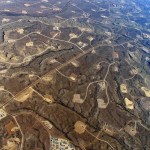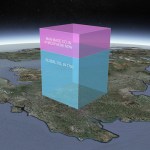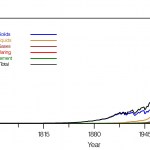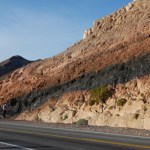carbon dioxide
No joke: California Governor Jerry Brown signed a bill to regulate 'gas' emissions from cows along with other sources of greenhouse gases, of course. According to an interview from NPR, dairy cows are the number one producer of methane in California. The problem with methane is that it is a major component of smog, although according to scientists at the University of California Santa Barbara, it is not the leading cause of global warming. In fact, agriculture-related methane and carbon dioxide emissions are responsible for only 6-7% of greenhouse emissions…
Research makes it increasingly clear that along with drilling for oil and mining coal, extracting natural gas from deep underground causes serious damage to the environment and to public health. On The Pump Handle, Kim Krisberg examines the contamination that may result from dumping fracking wastewater into disposal wells, writing "about 1,000 different chemicals are used in the fracking industry, with more than 100 being known or suspected endocrine disruptors." Researchers collected water samples downstream from wells in West Virginia, and after "exposing both female and male mammalian sex…
Just to provide a little perspective, here are the latest data and a graph on atmospheric carbon dioxide, with information going back 800,000 years. Present day is on the far right ("You are here"). The data come from the atmospheric monitoring program of the Scripps Institution of Oceanography, La Jolla, California and can be found here.
I've also noted the approximate period when homo sapiens first appeared -- thought to be around 150,000 to 200,000 years ago. During all human existence, pre-industrial levels of CO2 never exceeded around 275 parts per million (ppm). They touched 400…
"Being told about the effects of climate change is an appeal to our reason and to our desire to bring about change. But to see that Africans are the hardest hit by climate change, even though they generate almost no greenhouse gas, is a glaring injustice, which also triggers anger and outrage over those who seek to ignore it." -Sigmar Gabriel
With all of the scientific issues subject to politicization in this world, there's arguably none that raises such strong emotions as the issue of global warming and climate change. This is the final installment of a three-part series on how one could…
The threshold of 400 carbon dioxide molecules per million molecules of Earth's atmosphere is an arbitrary but still significant milestone, reflecting a near 50% increase in the concentration of the greenhouse gas since humanity first started burning fossil fuels for industry. Sure, the Earth has experienced hotter chemistry before, but Peter Gleick says it all the in the title of his post: The Last Time Atmospheric CO2 was at 400 parts per million Humans Didn’t Exist. The Arctic was also free of ice, and CO2 levels were changing 1000 times slower than they are today. Not that we can't survive…
On April 2nd, I posted three iconic graphs showing some of the clear observational evidence that we’re changing the climate. That post produced a substantial, and largely thoughtful response, and a request for more information and data along these lines.
Here are three more, along with a bonus fourth, all with a theme of exponential growth – the powerful force that is behind much of the concern about climate change and many other environmental and social challenges. Figures like these are increasingly called “hockey stick” curves, after the work of Professor Michael Mann and others in the…
Here are three iconic graphs (unfortunately, there are many, many more) showing just some of the clear observational evidence that we're changing the climate.
The first is the atmospheric concentration of carbon dioxide, measured at the Mauna Loa observatory in Hawaii. It shows the little ups and downs in concentration that varies with the seasons, but also the inexorable rise in this powerful greenhouse gas. There are now thousands of stations measuring these gases.
The second is the deviation from global average temperatures over the past 130 years. It also shows the natural variability (…
Sometime, about one year from now, the front pages of whatever decent newspapers are left will carry a headline like the one above, announcing that for the first time in human existence (or in nearly a million years, or 3 million years, or 15 million years), the global atmospheric concentration of carbon dioxide – the principal gas causing climate change – will have passed 400 parts per million.
That’s a significant and shocking figure. Unfortunately, it is only a temporary marker on the way to even higher and higher levels. Here (Figure 1 below) are the most recent (March 2013) data from the…
Here are two graphs that show the amount of carbon released into the atmosphere, mainly as CO2 and mainly form the burning of fossil fuels, per year, from various sources for a long span of time. Both graphs are based on the same data set. the first graph was created by the Carbon Dioxide Information Analysis Center and shows the breakdown between different sources of carbon. The second graph, which I made, simply shows the total, and over a shorter time span to make it easier to use for other purposes.
"Life exists in the universe only because the carbon atom possesses certain exceptional properties." -James Jeans
Here on Earth, every living thing is based around four fundamental, elemental building blocks of life: hydrogen, oxygen, nitrogen and, perhaps most importantly, carbon.
Image Credit: Robert Johnson / University of Pennsylvania.
From diamonds to nanotubes to DNA, carbon is indispensable for constructing practically all of the most intricate structures we know of. Most of the carbon in our world comes from long-dead stars, in the form of Carbon-12: carbon atoms…
December's calendar photograph is a battery of five solar cells that also stores electricity in series. The cells were invented and developed at the Weizmann Institute in the late 1970s. These not only converted sunlight into electricity, but also could store some of that energy using a battery-type setup with electrodes in a chemical solution, so that they could provide electricity day and night.
The idea of efficiently storing solar energy has taken more than one twist and turn since then - various forms of artificial photosynthesis, for example. Interestingly enough, one of the latest…
The eruption at Eyjafjallajökull-Fimmvörduháls continues on - the explosive spatter and bomb eruptions at the new central vent (on the second fissure) were impressive all night, making the hikers/cars/aircraft look like mites in comparison. This eruption has, so far, followed the pattern of Hawaiian-style volcanism quite well, so I thought it could be a good time to talk about what exactly Hawaiian-style volcanism is. There is a sequence of events that leads up to and follows the start of an Hawaiian-style eruption - although this sequence can stop at any point along the way - but it is…
I'm still playing catch-up after my week in the desert, so I've seen a lot of articles I've wanted to mention ... but a certain other volcano has taken up a lot of my time. However, I will attempt to make amends for that now.
By the way, would you believe Ubehebe Crater was closed? How do they close a volcano, anyway? However, I did get a great snap of a welded tuff on the road outside of Shoshone, CA.
A strongly welded tuff near Shoshone, CA. The dark interior is remelted volcanic ash/tephra surrounded by less welded pink tuff with abundant pumice clasts. Denison student David Sisak is on…
Leaving for Death Valley tomorrow - I'll be sure to take some pictures of Ubehebe Crater and the volcano at the Mirage. This will likely be the last new post until about a week from now, but look for the Erta'Ale Volcano Profile, maybe a new Mystery Volcano Photo and I'll leave a thread open for any new volcano news.
Colima in Mexico.
Eruptions reader Tim Stone sent me this image from Japanese astronaut Soichi Noguchi's Twitpic feed - it is a stunner of the caldera on Jebel Marra in Sudan. The only known historical eruption for this volcano was ~2000 BC within the Deriba Caldera, but it has…
We've been discussing calderas recently on Eruptions (I wonder why) and the Laacher See in Germany came up. I've actually been to the Laacher See on a field trip lead by one of the world's experts on the caldera, Dr. Gerhard Worner. So, I thought I'd post some pictures and talk a little about this feature that up until maybe 5 years ago, I didn't even know existed.
Laacher See, Germany
The Laacher See is a caldera in the Rhine Valley of Germany (see below). It is only ~30 km south of Bonn and ~60 km south of Koln (Cologne), just to the west of the Rhine River. It is part of the East Eiffel…
Some news for the last Friday in January:
Volcanic lightning captured over Redoubt in March 2009.
Tungurahua in Ecuador continues to erupt. Yesterday, the volcano spread ash over much of central Ecuador. Apparently people in Ecuador aren't taking the hazard of ash too seriously, with many ignoring recommendations to wear masks when the ash is falling. Over 50 explosions have been recorded over the last 24 hours at the volcano according to the Ecuadorian Instituto GeofÃsico, most of them small to moderate.
We also have a new USGS/Smithsonian Institute Volcano Activity Report. Much of the "…
This article is reposted from the old Wordpress incarnation of Not Exactly Rocket Science.
Fizzy drinks like Perrier and Coca-Cola are targeted at a huge range of social groups, but if fruit flies had any capital to spend, they'd be at the top of the list. Unlike posh diners or hyperactive kids, flies have taste sensors that are specially tuned to the flavour of carbonated water.
Humans can pick up five basic tastes - sweet, salty, sour, bitter and umami (savoury). But other animals, with very different diets, can probably expand on this set. And what better place to start looking for these…
Rising temperatures and high carbon dioxide emissions are the means through which humans are inadvertently causing the decline of several species. But one animal actively uses both heat and carbon dioxide as murderous weapons - the unassuming honeybee.
With their stings and numbers, bees already seem to be well-defended but they are completely outgunned by giant hornets (right). These two-inch long monsters are three times longer than several times heavier than tiny honeybees and raiding parties can decimate entire hives. European bees mount little in the way of an effective defence, but…
Volcano news ahoy, today brought to you by Islands.
Lake Kivu, located along the border the Democratic Republic of the Congo and Rwanda
A gorgeous satellite image (brought to us by the NASA EO) of a steam plume and ash from the ongoing eruption at Shiveluch in Kamchatka. The ash distribution stands out remarkably well on the white snow, with the central circle of ash near the vent/dome and then the wind-aided ash blanketing the terrain to the northeast of the volcano (and a little bit to the south).
Nature has a post reminding us that one of the big hazards at Nyiragongo/Nymuragira is not…
Things are busy - both volcanically and personally - so I'm going to just give you some links to a bunch of exciting/interesting/insane news:
West Mata erupting on May 5, 2009 in the Lau Basin.
According to a bunch of news sources, the eruption at Fernandina in the Galapagos is over (in spanish). That being said, the PNG noted that there is still a lot of carbon dioxide and sulfur dioxide being emitted, suggesting there is still a lot of degassing magma beneath the vents - at what depth (and will it erupt) is the question.
There is a lot of speculation that Nyiragongo (DRC) is erupting or…







